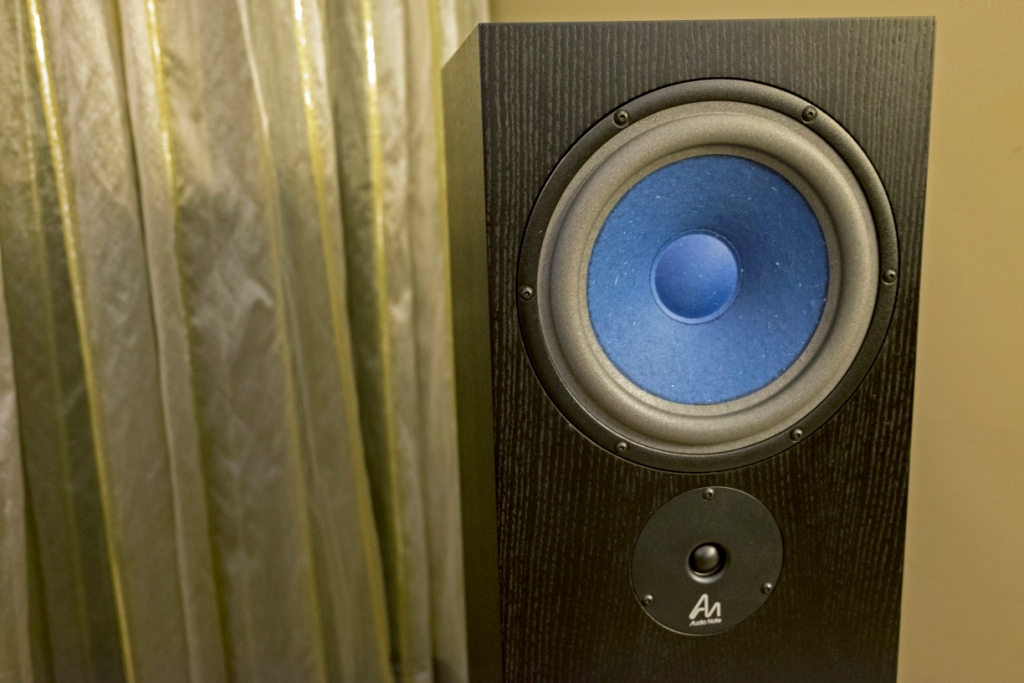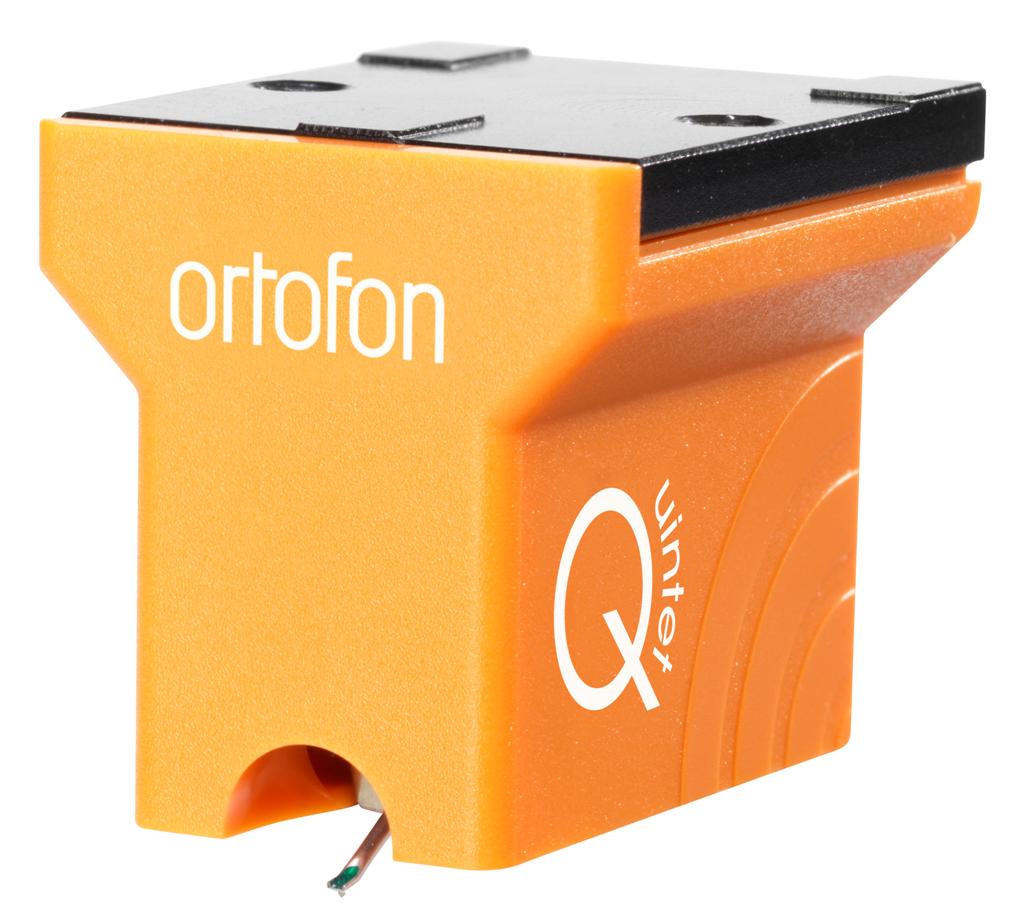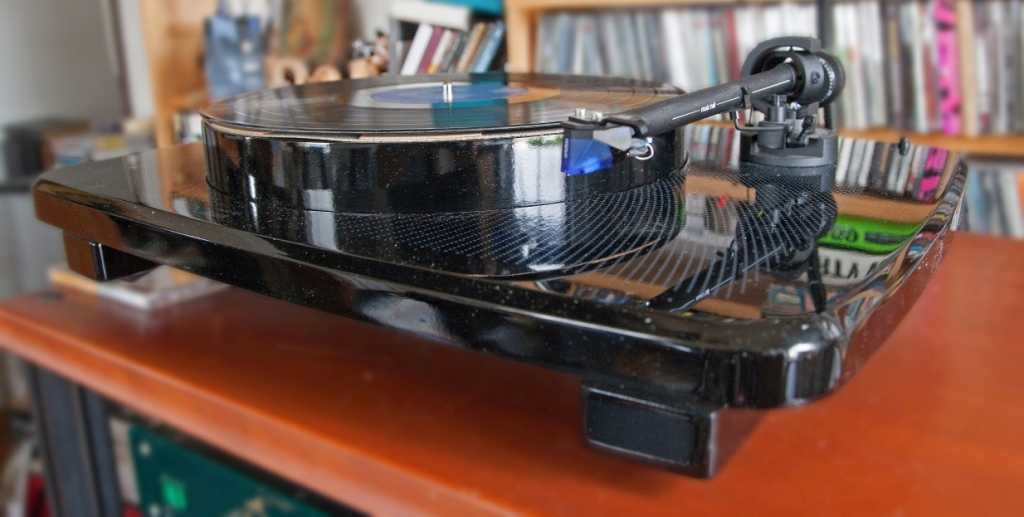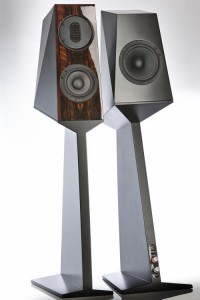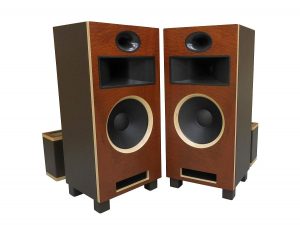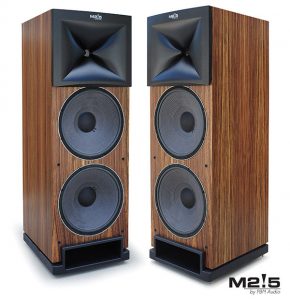
As I learned at the recent 2104 New York Audio Show, there is no lack of absurd loudspeaker designs executed with all sorts of wacky and expensive materials. While this year's blessed event was not as off-the-charts as prior shows in regard to loudspeakers that look like they were built by aliens with auditory requirements madly different from our own, there were contenders that made me wince both visually and especially, aurally.
You know what I'm talking about, that school of supposedly high-tech loudspeaker design incorporating beryllium tweeters, ceramic woofers, titanium speaker finishes, heck, titanium tweeters! "Drivers precisely machined out of massive slabs of aircraft-grade aluminum," boasted one manufacturer's site. Or, speakers finished in "Lamborghini Orange, a $2500 custom order option," noted another. There's more: "A multi driver quasi-point source array," literally 12 "planar ribbon drivers" suspended on an aluminum rod like a totem pole. Or if we're going low-tech but equally wrongheaded, IKYAudio's Red Lobestar Audio Speakers machined from industrial grade PVC pipe. Or Mannequin Speakers which drop a pair of 3" drivers into a headless mannequin's breasts, with your iPod plugging into the jack buried in her hard plastic vagina.
The Sound of Music
You know where I'm going and it's not a happy/friendly place. To my ears most of these extreme, complex, luxury-oriented designs don't sound like music; they sound like Ka-Ching! Of course, there were exceptions at the show, including the Focal Grande Utopias ($269,000), Verity Audio Monsalvats ($325,000), and the MBL Radialstrahler 101E Mk. II 101s ($70,500). But except for the MBLs, those speaker's designs aren't that crazy.
During shows, as I've wandered hotel hallways, stepping into exhibitor's rooms manned by men in dark suits playing bad lounge/jazz or even worse, white man blues, it's obvious that segments of our hobby center around greedy manufacturers designing Rube Goldbergs to rope in a chump with too much money and not enough experience listening to/enjoying music. These complex designs made from pricey materials are doomed to fail, and help to to doom our hobby. Joe Average already thinks we're crazy.

Hurry back, Jimmy Mack
But there are good signs afoot. Vinyl is back. (Rega sold more turntables in the past two years than in the previous 20.) Tubes and SETs are waaaaaaay back. And John DeVore of DeVore Fidelity, Brooklyn, New York City, is winning awards and customers.
When I speak of blessed events one of the more sacrosanct for high-end audio lovers in the New York City area is John DeVore's all too infrequent Monkeyhaus parties. I know, they've attained the status of myth. A place where rare records spin on a beautiful 50-year-old turntable playing through equally rare amplifiers and choice DeVore Fidelity loudspeakers. A place where you drink, smoke cigars, talk shop, drink some more, and talk some more. A place where you listen. And listen closely, deeply. All while enjoying the camaraderie of fellow music lovers. Cats roam free. Sometimes children. Sometimes wives. The only admission to Monkeyhaus is your good humor and a good vinyl LP.
I've gratefully attended a few Monkeyhaus events. And way back when (early 2000's?) they wet my whistle quick for a pair of DeVore Fidelity loudspeakers I could call my own. Consequently, I may have owned more variations of John's Gibbon speakers than any soul north of the Mississippi. I began with DeVore Fidelity Gibbon 8s, then the Super 8s, then The Nines (before that, Audio Physic, ProAc, Spendor, and B&W boxes filled my small apartment. In between ownership(s) I reviewed the exceptionally sweet DeVore Fidelity 3XLs, the Super 8s, The Nines, and even a short-lived home theater speaker reviewed as a pair, the Gibbon 7.1s. Does this mean I'm biased when reviewing DeVore Fidelity's Orangutan O/93 loudspeakers? It means I well understand the DeVore Fidelity sound, and John's adherence to principles like naturalness, transparency, and dynamics, equaling to me, faithfulness to the music heard from only a few loudspeakers. As DeVore's designs evolve we are truly "getting closer to the music" to paraphrase his company's motto.
Backtrack: I don't mean to imply with my complexity-bashing intro to this review that John DeVore's speakers are the opposite: simpletons-on-steroids. I don't have the level of technical knowledge to say whether John's designs are more or less complex. And he ain't giving away his crossover configuration. I do know that the Gibbons I have owned and reviewed were ported two-way affairs (well, The Nines had side-firing woofers), using treated paper cone woofers and silk dome tweeters. Tried, tested and true elements of speaker design. Step up to the flagship Silverbacks and you simply get more DeVore Fidelity to enjoy.


Sounding Out Soul
I hear a house sound in John's speakers, which are as a group natural-sounding, non-fatiguing, with warmth, transparency, and exceptional dynamic range. John's a drummer, and he knows how to boogie. His speakers boogie down below, and produce great finesse and transparency throughout the frequency range.
The slightly smaller brother of the $12k Orangutan O/96, the $8400 Orangutan O/93 (referring to the loudspeaker's 93dB sensitivity) features a new version of DeVore's 10-inch paper cone woofer with phase plug (designed to John's specs) and the same horn-loaded 1-inch silk dome tweeter, "retaining much of the clarity and tonality of the O/96 at a lower sensitivity in a lower priced speaker," states the DeVore Fidelity website.
From the informative O/93 manual: "The exquisite cabinetry incorporates matched exotic wood veneers, hand rubbed lacquers and carefully selected materials to give the speaker system as a whole its intended voice. Under the skin the materials are just as impressive, from the solid machined copper binding posts, silver wire and exotic oil-filled capacitors, to the hand built, hardwired DeF-SVDX crossover and matched custom-built drivers."
The O/93's frequency bandwidth is 28Hz - 31kHz (that's seriously low, kids!), sensitivity: 93dB/W/M, impedance: 10-12 Ohms (that dips to 8 Ohms as needed), with dimensions of 10"D x 15"W x 35.5"H, weight of 45 pounds each. Two smallish parallel ports adorn the speakers' lower backside. Four small wooden nubs act as footers (though the speaker looks like it's sitting directly on the floor). My review sample came in the O/93's standard finish: gorgeous Fiddleback Mahogany fronts and Mink (stained) Maple sides and rear. Lovely.

10 Questions with the Tallest Guy in the Room
To learn more about the O/93's design I emailed the taller than 6'5" big bad John a few questions.
PF: What speaker most influenced the design of the O/93? I've read reviews citing its similarity to certain Audio Note or Snell boxes (I own the Snell J/II series).
John DeVore: There aren't many 10" 2-way speakers out there, an old Boston Acoustics model here, a Dynaco there, though both of those are well over 30 years old. Original Snells were an influence too, but all these were fairly inexpensive, compromised designs. They did do one thing though; the Bostons in particular, suggested to me what potential there might be in a 10" 2-way speaker with a 1" dome tweeter. I sold the Bostons when I started in retail, and it was clear to me that the 10" 2-way was far better than the more expensive model in the line that added a midrange driver. More influential though were the larger designs from Altec and the like. Explosive dynamics, rich tonal colors, high sensitivity and high impedance. The goal of the Orangutan series was to provide a large measure of those qualities, without the drawbacks, in a domestically acceptable (even desirable) package.
PF: What qualities and literal elements were taken from previous DeVore Fidelity loudspeakers?
John DeVore: Literally only me, I suppose. Everything I learned designing the Gibbons and Silverbacks led me to where I could tackle the Orangutans. My taste is apparent in the sound and appearance of every product that bears my name, so they do share quite a lot in that sense.
PF: What does the shallowness of the O/93 box achieve?
John DeVore: Ha—well, that question is off by 90 degrees. The shallowness achieves width. For a given volume of space there's a depth, width and height. Make the box wider and it either gets shorter or shallower. Or both. The baffle width accommodates the larger driver and pushes the step response frequency lower, increasing the efficiency of the system in the room. Simplistically, more of the acoustic output is thrown forward into the room towards the listener and less "wraps around" the sides of the speaker and away from the listener.
PF: And this is one of the shallower speakers out there, right? And "more acoustic output thrown forward," does that account for the immediacy and quickness of the speaker? Do you give up any depth of soundstage with a wide baffle compared to a thinner baffle? Soundstage is hard to gain in my small room.
John DeVore: If by shallower you mean it has a higher ratio of width-to-depth, it might well be one of the shallowest out there. Immediacy and quickness are subjective terms that are not clearly defined. Technically, the baffle width only effects the diffraction, and related to that, the tonality. Those effects combined with other things going on in the design add up to the final acoustic package, but as far as a direct relation of one-to-the-other it's not that simple.



PF: Explain to the ignorant (me) what a difference an impedance of 10 ohms makes.
John DeVore: It's part of the load the amplifier sees. An amp makes specific power into a specific load, and as that load varies, so does the power and bandwidth of the amp. For tube amps, generally, the higher the speaker impedance, the less work the output transformer has to do, and the better the amp will sound. This is not always the case, as some tube amps are optimized for more typical low-impedance speakers, but it usually is.
PF: What are the ideal amplifiers to drive the O/93s?
John DeVore: Tons of different amps, tube, transistor, low-powered, high-powered. They are very unfussy. (I can attest to this. DeVore has many different amps at Monkeyhaus)
PF: Same treated paper cone woofer as in O/96? How different?
John DeVore: Same un-treated paper cone and surround. Very different motor system (coil, magnet, gap and pole). The motor on the O/93 woofer is a simplified, scaled-down version of the O/96 woofer.
PF: What's the origin and basic design of the tweeter?
John DeVore: Again, if we go back 30-40 years to a time when dome tweeters had already begun replacing compression drivers, but sensitivity was still something speaker designers were striving for, a great many dome tweeters were horn-loaded. Gradually, as big solid-state amps became High-End and speakers started getting correspondingly difficult to drive these tweeters were phased out to where they are now essentially extinct. Both the non-horn-loaded gibbon tweeter and the horn-loaded Orangutan tweeter are loosely based on some of my favorite tweeters from that period—of course with a good dose of modern technology added.
PF: So a higher impedance speaker and horn loaded tweeters, both older technologies that were right in the first place? Then disused starting in the 60s and beyond?
John DeVore: Certainly "right" for some amps. Remember, speaker sensitivity declined along with the rise of Japanese mega-receivers and early American High-End solid-state amps. In that sense the speakers of the time remained "right" for those certain amps of the time. In fact I've found that some higher-powered High-End amps that can sound good into a difficult speaker load can sound pretty bland into a higher sensitivity, higher impedance speaker load. On the right amplifier though, swapping a "normal" speaker for one with a load like the Orangutans is a revelation.


At my "Haus"
Once the O/93s were delivered, John came by to oversee setup. I assumed the O/93s would drop neatly into the same location as my Nines, but oh no. After much fiddling and moving, then application of blue tape on the floor to lock down location and various folded-up playing cards placed under the speaker's corner feet to eliminate possible wobble, the O/93s sat closer than The Nines, with less of a toed-in pitch. After John left and further listening ensued I moved the loudspeakers even closer to my listening position, resting at about 5.5 feet. Too far back and the speaker's plentiful bass overwhelmed my small room, too close and I lost soundstage. Not quite near-field, but closer than you'd expect.
Though The Nines have side-firing woofers (one per speaker) the O/93's single 10" woofer produced better defined, resolute and weightier bass notes in my space. Where The Nines cast a larger soundstage with good depth, the O/93s were more direct sounding and better fleshed out, with more realistic images, and greater immediacy but less depth; something hard to achieve in my small room. John may think "immediacy" is an ill-defined term, but the O/93s "let go of the notes" (who coined that term? Art Dudley? Robert Reina? Herb Reichert? Alfred E Newman?) faster and with more weight (FAT!), greater definition and mucho precision than The Nines, and with consistent warmth. The O/93s are warm and generous of nature, but not at the expense of resolution and upper frequency extension and slam (and what is that a dirty word to sum? As a drummer music better slam when necessary) . Extremely coherent top to bottom, the O/93s revealed the fine details of my LPs better than I thought was possible. I would go so far as to say that when everything was dialed in, my system (Kuzma turntable, Shindo electronics) with the O/93s created a better overall sound than I have heard at any audio show, and frequently at any Monkeyhaus. I may have experienced more jump factor or a different dimension or larger perspective at those events, but never with greater intimacy, dynamics and soul-stirring musicality than right here in my humble listening space. The O/93s produced rock solid and humanly scaled images, whether playing hard bop or electronic LPs, classical or rock. Feed the O/93s some modern electronica such as The Haxan Cloak and the roof came off the mutha. Grace them with EMI classical LPs and they produced extreme degrees of subtlety, refinement, and tremendous dynamics. Rock, like the latest Led Zeppelin reissues, charged out of the O/93s with a dynamic force I have never heard in my listening space. Stick with the walking bass and dancing drums of such hard bop heroes as Hank Mobley, Wayne Shorter, or Freddie Hubbard and you may never want for another loudspeaker. Allying warmth with excellent dynamics, punch with purity, and a refined upper frequency delivery with a transparent (and warm) midrange and tremendous, soul-enriching low end and you have a loudspeaker for music lovers. Jazz vinyl lovers, digital rock roustabouts, classical connoisseurs, and dance music B-Boys will want for nothing once the O/93s pass their portal.
Through its Paces
I brought out a few of my favorite records to evaluate the O/93s, including Pat Metheny's What's It All About (Nonesuch), Eddie "Lockjaw" Davis' various Prestige CookBook LPs (as well as his terrific Trane Whistle Big Band LP), Aphex Twin's Syro (Warp), FKA Twigs' EP (Young Turks), The Soulful Moods of Gene Ammons (Moodsville), Francois Hardy Sings About Love (Marble Arch), Radiohead's In Rainbows and Fennesz's Becs (Editions Mego).
Referring to my notes (ahem): The dynamics of Lockjaw's Cookbook Vol 1. are registered full-on, with upright bass and drums chugging madly, deeply, and pushing the beat hard. As Lockjaw shouts and squawks Shirley Scott's Hammond B3 organ purrs, blasting the air all around, practically a 3D experience. On opening track "Skillet," bass notes are even deeper. Pure thrill. When drummer Arthur Edgehill switches ride cymbals you can feel it. Your eyes move to follow. Flipping records to Lockjaw's Jaws, the different recording environment is heard in the extreme. One of the O/93's great qualities is their ability to get out of the way, creating a transparent, emotional connection to the music and the musicians. Through the O/93s each LP is heard in its unique recording studio environment, to a degree that is almost spooky. Time travel.
Flipping again to Lockjaw's Trane Whistle LP, you hear what a large soundstage the O/93s can cast even in a smaller room. Here is unity of sound, even with a big band wailing in a superbly layered mono recording. Lockjaw exulting above it all, and great brass shouts behind. Here is soul.
Sticking with the 50s/60s soul-jazz itch, I drop Gene Ammons' Soulful Moods on the Kuzma Stogi/Stabi and become drenched in the wet soul sauce. Ammons' rich, lush saxophone mellows out my mood. Snare drum brush work swoops along under the swinging bass work. Sublime.
Francois Hardy's French pop is pleasant enough, but I need more thrills. FKA Twigs, one Tahliah Debrett Barnett, is an English singer-songwriter, producer and dancer originally from Gloucestershire and currently based in London. FKA Twigs' recently released LP1 followed the four-track EP I own, but the message is the same: rich, rounded bass underpinning sensual soul-electronica, absolutely dripping in hot sex atmospherics. Singing like a women starved then savaged, the music of FKA Twigs' LP1 is deep cavernous electronica with spacey sci-fi tones and a floorboard-splitting low end. So low I had to sprint to turn it down in fear that my downstairs neighbors would lose consciousness before calling the police. Here, the O/93s delivered some serious deep space bass tranquility. To a graphic extreme.


The throbbing bass and web of weird science sounds of Fennesz's Becs recalls a nightmare vision of pipe organ, strings and electronic bass tones battling for supremacy. Pat Metheny's What's It All About is the opposite, one elaborate guitar creating a humid world of giant, elongated bass notes and upper frequency string exoticism. Playing Linda Manzer's 42-string Pikasso guitar, Metheny recreates songs made famous by The Carpenters, Jobim, Carly Simon, The Beatles and others into a reharmonized macabre dance. Metheny recites these classics' familiar melody, and then takes them on an otherworldly journey. Through the O/93s Metheny's music filled the room with strings and sound.
I closed my O/93s listening session with Radiohead's In Rainbows and Aphex Twin's recent return to commercial recording, the 3-LP Syro. The Radiohead disc sounded horrible, muddy, compressed, without any definition. I was surprised, but hadn't listened in years. Here's one case where the CD is definitely the way to go. Syro, on the other hand, was fantastic. Its sweltering low end gave the O/93's ten-inchers a workout, producing many variations of bass bombs, farts, thrusts, and lift-offs. To this subsonic stew Aphex Twin dials in amusing keyboard melodies consisting of childlike chords and single-note doodles. I can't name the exact Syro song I used, but it's on the LP side that has what looks like a peanut butter sandwich with an eyeball peaking out of one corner on the label. Syro is a sonic and musical delight, Aphex Twin (Richard James) having lost none of his talent for electronic absurdity and musical merriment. The O/93s delivered Syro just as it did the other LPs: uniquely, transparently, with slam, spot-on tonality and timbre.

The Wrap Up
I toss around a lot of adjectives in trying to adequately describe my listening experience with the DeVore Fidelity O/93s. A special speaker, one with richness, punch, finesse and clarity (there I go again); the O/93s ultimately produced a singular sound, a natural sense of wholeness that defies single words or strings of descriptors. A beautiful speaker, the O/93s get so many things right, qualities that add up to a final very satisfying whole. The idea of dissecting its qualities into tightly defined boxes cheats the speaker, slicing up its splendor into dry single words and phrases. Just as you don't listen to music analyzing it bar by bar, neither should you tally a speaker's ultimate performance focusing on its singular traits, as heavenly or sublime as those traits may be. I was ultimately delighted to hear what the O/93s could do with each LP, what they would reveal, and how that would make me feel. And they always made me feel happy, hopping around the room with bebop, moving my head with electronic beats, or simply dropping back and getting lost in the sweet flow of sounds.
While my 25 WPC Shindo Haut Brion easily drove the DeVores, making the most of their inherently rich character and warm tonality, I bet they would provide a feast with lower powered SETs. And while I stuck exclusively with vinyl for my evaluation of the O/93s, my recent review of the Line Magnetic DAC proved the DeVores to be ample purveyors of the 1s and 0s. I suggest you get your mind right, get your ears in gear and hear these speakers, pronto. Simply put, they make glorious music. Ken Micallef
DeVore Fidelity Orangutan O/93s
Retail: $8400
DeVore Fidelity




